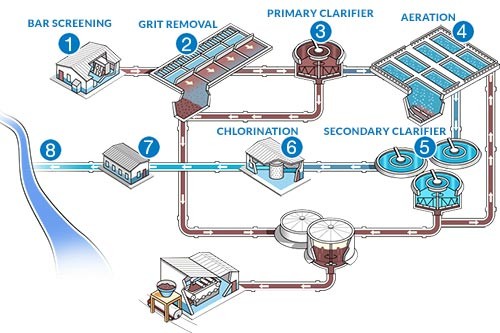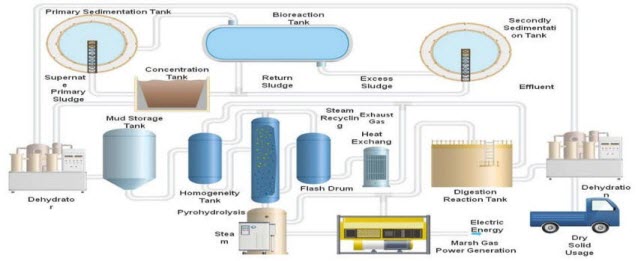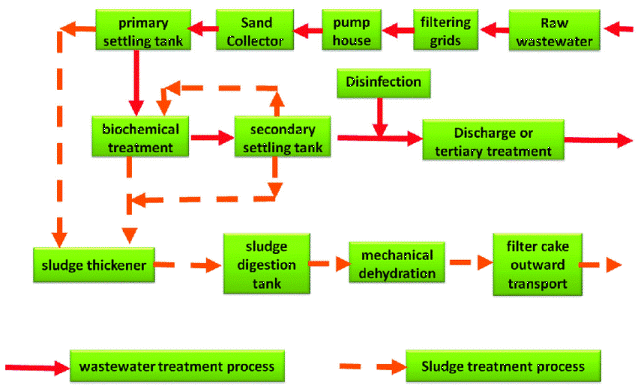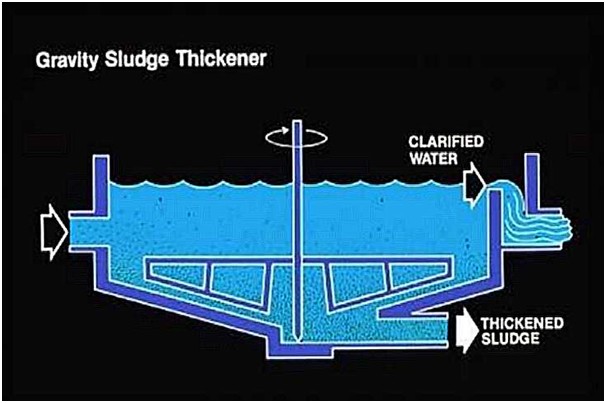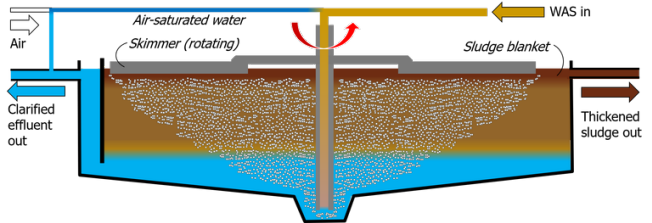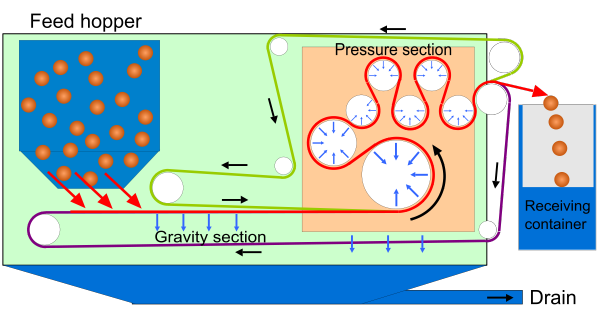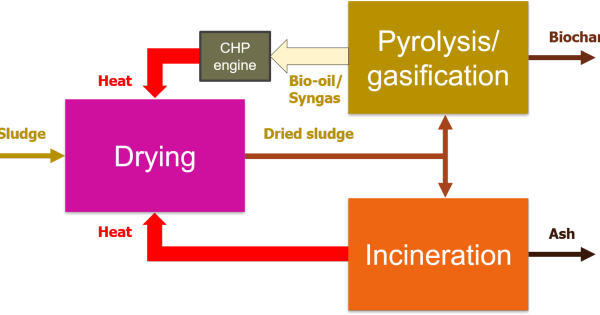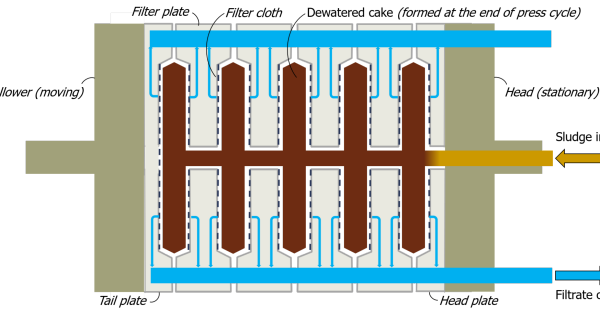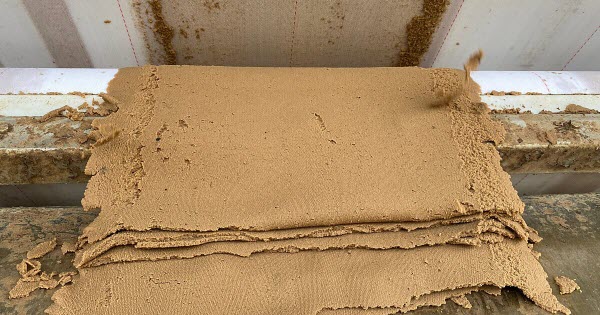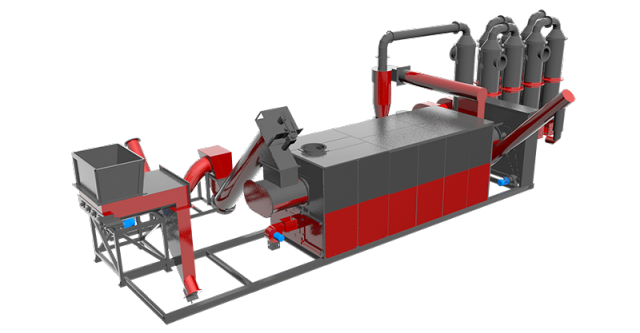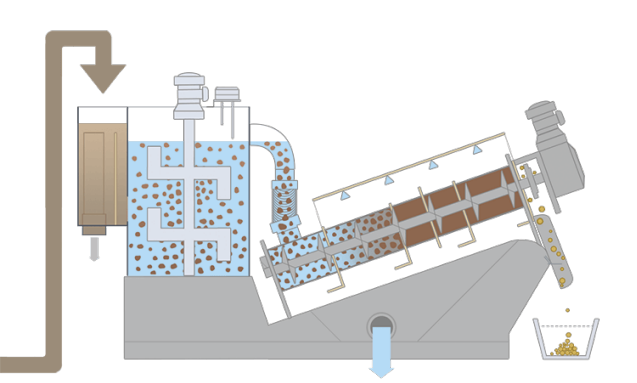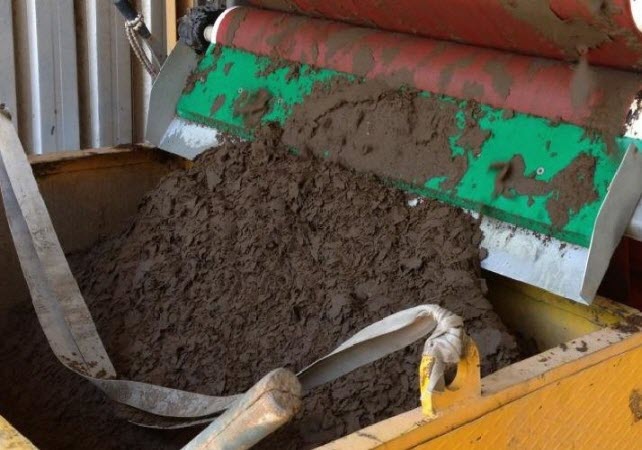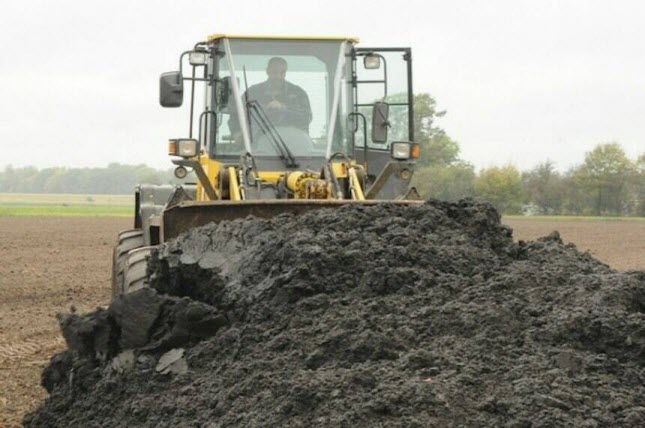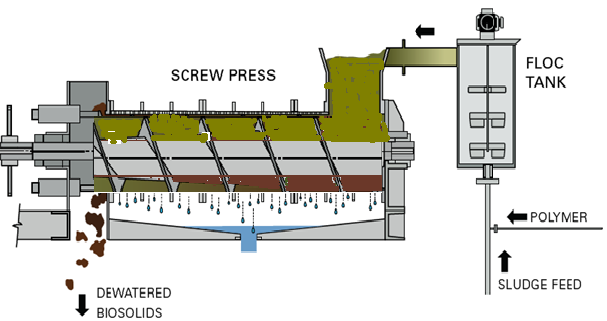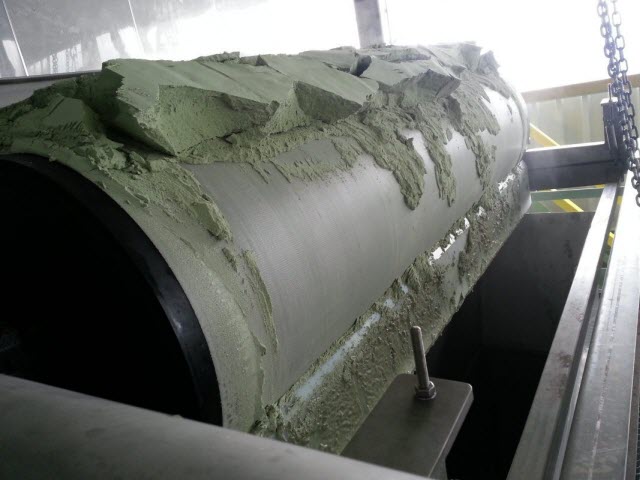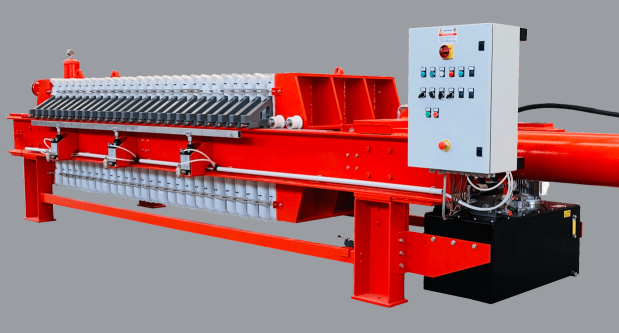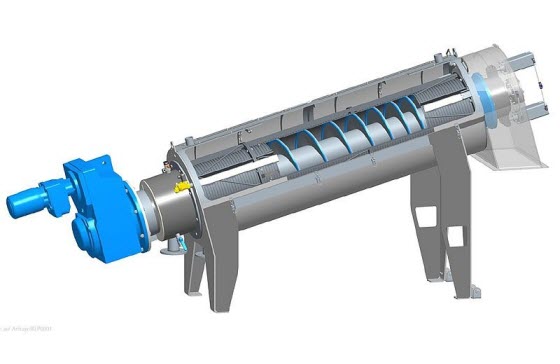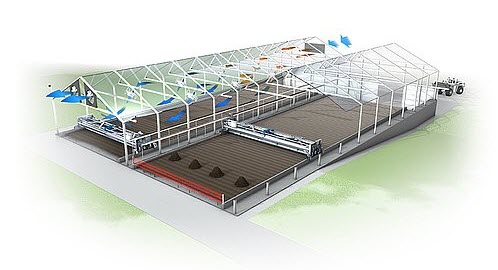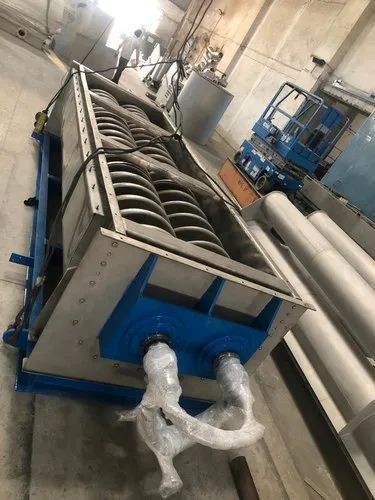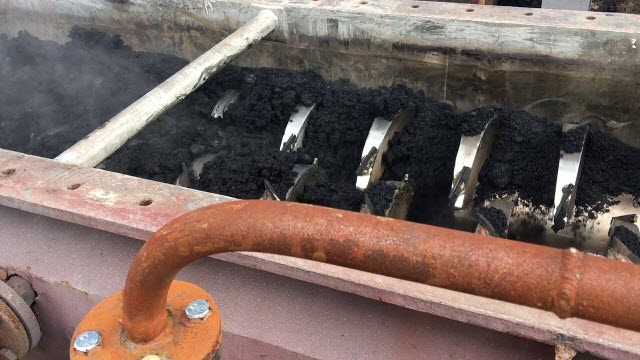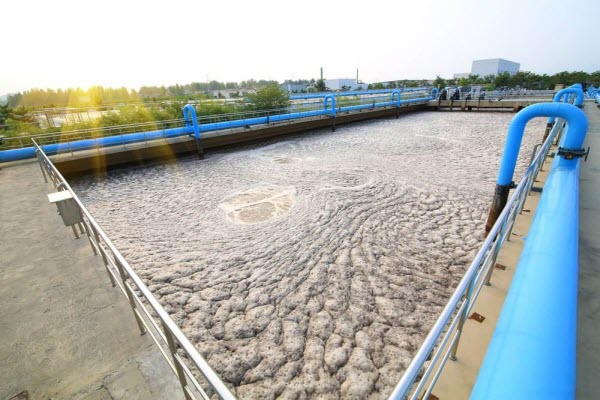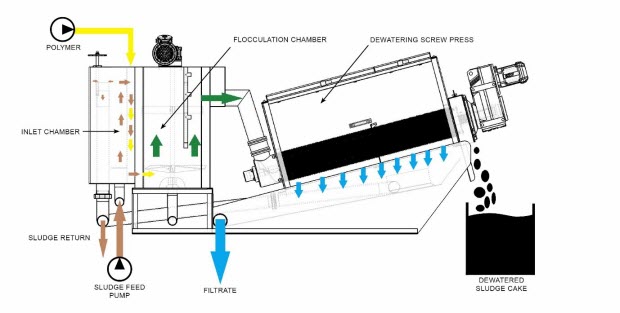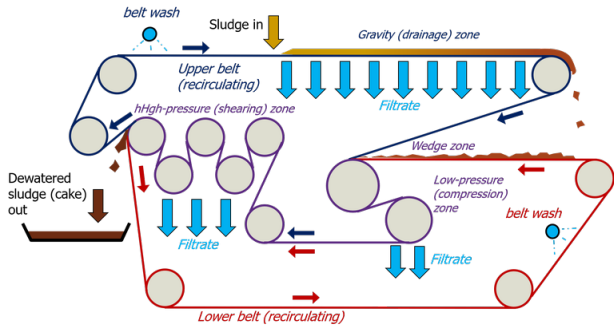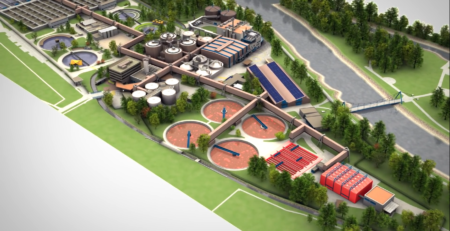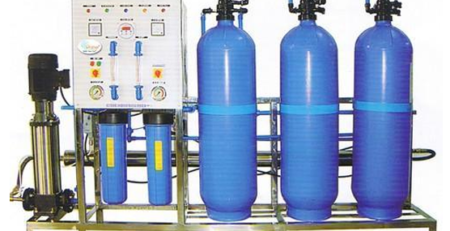Sludge Treatment Plants
Sludge treatment plants are facilities that process sewage sludge generated during the treatment of wastewater. Sewage sludge is a semi-solid by-product of wastewater treatment that contains organic matter, nutrients, and pathogens. If left untreated, sewage sludge can pose a risk to human health and the environment. Sludge treatment plants use a variety of processes to reduce the volume and stabilize the sludge before disposal or reuse.
The primary goal of sludge treatment plants is to reduce the amount of sludge produced and make it safe for disposal or beneficial use. This is accomplished through a series of physical, chemical, and biological processes that transform the sludge into a more stable and manageable material. The specific treatment process used will depend on the characteristics of the sludge, the treatment plant design, and the regulatory requirements in the area.
The typical sludge treatment process includes the following steps:
- Thickening: The sludge is first pumped into a thickener tank where the water is separated from the solids. This reduces the volume of the sludge and makes it easier to handle.
- Stabilization: The sludge is then treated to stabilize it and reduce its odor. This is typically done through aerobic or anaerobic digestion, which breaks down the organic matter in the sludge and converts it into biogas and a stabilized biosolid material.
- Dewatering: The stabilized sludge is then dewatered to remove as much water as possible, further reducing its volume and weight. Common dewatering methods include centrifugation, belt presses, and filter presses.
- Disposal or reuse: The dewatered sludge can be disposed of in landfills or incinerated, or it can be further treated for beneficial reuse. Beneficial reuse options include land application as fertilizer, composting, or conversion to energy through anaerobic digestion.
Sludge treatment plants play a critical role in protecting public health and the environment by safely managing the by-products of wastewater treatment. They also provide opportunities for resource recovery and sustainable waste management practices.
1. Thickening:
Thickening is an important step in the treatment of sludge to reduce its volume and improve its handling and processing characteristics. The thickening process involves removing excess water from the sludge to increase its solids content. Here are some common techniques used for thickening sludge:
A. Gravity thickening: Gravity thickening involves allowing the sludge to settle under gravity to separate the solids and water. The sludge is stored in a tank or basin, and the solids settle at the bottom while the water rises to the top. The solids are then removed using a sludge scraper or pump. Gravity thickening is a simple and cost-effective technique, but it requires a large space and can be slow.
B. Dissolved air flotation (DAF): DAF involves introducing air into the sludge to create small bubbles that attach to the solids and float them to the surface. The solids are then removed using a skimmer or scraper. DAF is a faster and more efficient technique than gravity thickening, but it requires a higher energy input and can be more expensive.
C. Centrifugal thickening: Centrifugal thickening involves spinning the sludge in a centrifuge to separate the solids and water. The centrifugal force pushes the solids to the outside of the centrifuge, and the water is removed through a discharge port. Centrifugal thickening is a fast and efficient technique, but it can be expensive and requires a high energy input.
D. Belt filter press: Belt filter presses use a series of rollers and belts to squeeze the sludge and remove the excess water. The sludge is fed onto a moving belt, and the rollers press the sludge to increase its solids content. The excess water is removed through the belts, and the solids are collected in a container. Belt filter presses are a fast and efficient technique, but they can be expensive and require a high energy input.
2. Stabilization:
Stabilization is a sludge treatment process that involves reducing the organic content of the sludge and making it more stable and less odorous. Stabilization can be achieved through biological or chemical methods. Here are some common techniques used for stabilization of sludge:
A. Aerobic digestion: Aerobic digestion involves exposing the sludge to air and microorganisms to break down the organic matter. This process produces carbon dioxide and water as by-products and reduces the volume and odour of the sludge. Aerobic digestion is a relatively fast process and produces a stable and safe end product.
B. Anaerobic digestion: Anaerobic digestion involves treating the sludge in an oxygen-free environment, which promotes the growth of anaerobic bacteria. These bacteria break down the organic matter and produce biogas, which can be used as a source of energy. Anaerobic digestion is a slower process than aerobic digestion, but it can produce a more stable end product and generate energy.
C. Lime stabilization: Lime stabilization involves adding lime to the sludge to raise the pH and reduce the organic content. This process can also help to reduce the pathogens in the sludge and make it more stable. Lime stabilization is a relatively simple and inexpensive process, but it requires careful monitoring of the pH and can produce a high volume of by-products.
D. Heat treatment: Heat treatment involves heating the sludge to a high temperature to kill the pathogens and reduce the organic content. This process can also produce a stable end product with low odour. Heat treatment is a relatively fast process and can produce a safe and stable end product, but it can be expensive and require a high energy input.
3. Dewatering sludge treatment process
Dewatering is a sludge treatment process that involves removing the water from the sludge to reduce its volume and weight. Dewatering can be achieved through mechanical or chemical methods. Here are some common techniques used for dewatering of sludge:
A. Belt filter press: A belt filter press involves passing the sludge through a series of belts that press and squeeze the sludge to remove the water. This process can produce a dewatered sludge cake with a high solids content.
B. Centrifuge: A centrifuge involves spinning the sludge at high speed to separate the solids from the water. This process can produce a dewatered sludge cake with a high solids content, but it requires a high energy input.
C. Screw press: A screw press involves pressing and squeezing the sludge using a rotating screw to remove the water. This process can produce a dewatered sludge cake with a high solids content and requires a lower energy input than a centrifuge.
D. Drying beds: Drying beds involve spreading the sludge on a porous bed and allowing it to dry in the sun and wind. This process can produce a dewatered sludge cake with a low moisture content, but it requires a large area and is weather-dependent.
E. Polymer conditioning: Polymer conditioning involves adding chemicals to the sludge to bind the solids together and improve their dewatering properties. This process can improve the efficiency of mechanical dewatering techniques and produce a dewatered sludge cake with a high solids content.
The choice of dewatering technique will depend on the type and quantity of sludge, the desired level of dewatering, and the available resources. It is important to select the most suitable technique to achieve optimal recovery while minimizing costs and energy consumption.
4. Disposal or reuse sludge treatment process
Disposal or reuse is the final step in the treatment of sludge, which involves removing the sludge from the treatment plant and either disposing of it or reusing it for other purposes. Here are some common techniques used for disposal or reuse of sludge:
A. Land application: Sludge can be applied to agricultural land as a fertilizer and soil conditioner. The nutrients and organic matter in the sludge can improve the soil quality and promote plant growth. However, land application requires careful monitoring to ensure that the sludge does not contain harmful pathogens or contaminants that could pose a risk to human health or the environment.
B. Incineration: Incineration involves burning the sludge to a high temperature to convert it into ash and gases. The ash can be disposed of in a landfill, and the gases can be used as a source of energy. Incineration is a reliable method of sludge disposal that can produce a stable end product, but it can be expensive and require a high energy input.
C. Disposal in a landfill: Sludge can be disposed of in a landfill, where it is buried and covered with soil. The landfill must meet strict regulations to ensure that the sludge does not contaminate the environment or pose a risk to human health. Landfill disposal is a relatively simple and cost-effective method of sludge disposal, but it can have long-term environmental impacts.
D. Biogas production: Sludge can be used as a source of biogas through anaerobic digestion. The biogas can be used as a source of energy to power the treatment plant or sold to other users. Biogas production can be a sustainable and cost-effective method of sludge disposal, but it requires careful management to ensure the quality and safety of the product.
Dewatering and drying techniques of sludge
Sludge is a semi-solid material that contains water and solids. Dewatering and drying are essential processes in sludge management to reduce the moisture content and volume of sludge for disposal or further processing. Here are some common dewatering and drying techniques for sludge:
i. Mechanical dewatering: Mechanical dewatering techniques include belt filter presses, screw presses, and centrifuges. These techniques use pressure, gravity, or centrifugal force to separate the water and solids in the sludge. Mechanical dewatering can achieve a high level of dewatering and produce a drier cake, which is easier to handle and transport.
ii. Thermal drying: Thermal drying techniques use heat to evaporate the water in the sludge. These techniques include direct drying, indirect drying, solar drying, and freeze-drying. Thermal drying can achieve a high level of moisture removal and produce a dry product, which can be used as fuel or fertilizer.
iii. Electro-dewatering: Electro-dewatering is a technique that applies an electric field to sludge to remove the water. This technique can achieve a high level of dewatering and reduce the sludge volume.
iv. Vacuum-assisted drying: Vacuum-assisted drying involves applying a vacuum to the sludge to evaporate the water. This technique can achieve a high level of moisture removal and produce a dry product.
v. Composting: Composting is a natural process that uses microorganisms to break down organic matter in the sludge. This process can reduce the sludge volume and produce a stabilized product, which can be used as soil conditioner or fertilizer.
vi. Pyrolysis: Pyrolysis is a thermal process that uses high temperatures to break down the sludge into solid and gaseous products. This process can produce a solid fuel and reduce the sludge volume.
Each technique has its advantages and disadvantages, and the choice of technique will depend on the type of sludge, the desired level of dewatering and drying, and the available resources. It is important to select the most suitable technique to achieve optimal recovery while minimizing costs and energy consumption.
Sludge Dewatering
Sludge dewatering is a crucial step in the treatment of wastewater sludge, as it removes water from the sludge and reduces its volume and weight, making it easier and less expensive to handle and transport. Dewatering also stabilizes the sludge by reducing the amount of available moisture, which slows down the decomposition process and helps prevent odors and the growth of pathogens.
There are several methods used for sludge dewatering, each with its own advantages and disadvantages. Some common methods include:
a) Centrifugation: This method involves spinning the sludge at high speeds in a centrifuge to separate the water from the solids. The separated water is discharged, while the solids are discharged as a cake.
b) Belt presses: Belt presses use a series of belts to squeeze the sludge, forcing the water out through small pores. The dewatered sludge is then discharged as a cake.
c) Filter presses: In this method, the sludge is pumped into a series of plates with filter cloths. The plates are then squeezed together, forcing the water out through the cloths and leaving a cake of dewatered sludge.
d) Drying beds: Drying beds are open-air basins that are lined with sand or other porous material. The sludge is pumped onto the beds and allowed to dry out in the sun, with the water draining through the porous material and evaporating.
e) Thermal drying: This method involves heating the sludge to evaporate the water, leaving a dry, granular material. The thermal drying process can be done using a variety of methods, including direct or indirect drying, fluidized bed drying, or spray drying.
When choosing a sludge dewatering method, several factors should be considered, including the characteristics of the sludge, the volume of sludge to be dewatered, the required level of dewatering, and the availability of space and resources.
In addition to reducing the volume and weight of the sludge, dewatering also has the potential for resource recovery. The dewatered sludge can be further treated for beneficial reuse, such as land application as fertilizer or composting. In some cases, the dewatered sludge can also be converted to energy through anaerobic digestion or incineration.
Sludge dewatering is a critical step in the treatment of wastewater sludge, and the choice of dewatering method can have significant impacts on the efficiency, cost, and environmental sustainability of the sludge treatment process.
Dewatering Detail
This process involves removing the water from the sludge to reduce its volume and make it easier to handle and transport.
1. Incineration:
This process involves burning the sludge at high temperatures to reduce its volume and destroy any pathogens present. The product is ash, which can be disposed of in a landfill.
2. Land application:
This process involves applying the sludge to land as a fertilizer. This method is regulated to ensure that the sludge does not contain any harmful pathogens or chemicals.
wastewater sludge treatment plants play a crucial role in managing the waste generated during the wastewater treatment process, ensuring that it is safely and effectively treated before disposal.
Dewatering Detail in Sludge Treatment Plants
Dewatering is an essential step in the treatment of wastewater sludge. This process involves removing water from the sludge to reduce its volume and make it easier to handle and transport. There are several methods used for dewatering wastewater sludge, including:
1. Filter press:
This process involves passing the sludge between two belts under pressure to squeeze out the water. The resulting cake is then removed from the belts and disposed of.
2. Centrifuge:
This process involves spinning the sludge in a centrifuge at high speed to separate the solids from the liquid. The resulting cake is then removed and disposed of.
3. Screw press:
This process involves passing the sludge through a series of screws that apply pressure to squeeze out the water. The resulting cake is then removed and disposed of.
4. Plate and frame press:
This process involves passing the sludge between a series of plates and frames under pressure to squeeze out the water. The resulting cake is then removed and disposed of.
5. Vacuum filter:
This process involves passing the sludge through a vacuum filter to remove the water. The resulting cake is then removed and disposed of.
The choice of dewatering method depends on the characteristics of the sludge, the volume to be processed, and the available equipment. Dewatering can reduce the volume of sludge by up to 80%, making it easier to transport and dispose of. The resulting cake can be sent to a landfill, incinerated, or used as a fertilizer, depending on the regulations and the treatment goals of the plant.
Sludge Dewatering Equipments offering by Waterman Engineers Australia
(i) Filter press
(ii) Screw pressSludge dewatering equipment is used in wastewater treatment plants to remove water from sludge, reducing its volume and making it easier to handle and dispose of. Waterman Engineers Australia offering two common types of sludge dewatering equipment are filter presses and screw presses.
(i) Filter Press:
A filter press is a piece of equipment that uses a series of plates and frames to separate solids from liquids. The sludge is pumped into the filter press, where it is fed between the plates. Pressure is then applied to the plates to squeeze out the water and separate the solids. The solids are collected as a cake between the plates, and the water is discharged as filtrate. The cake can then be removed and disposed of. Filter presses can be operated manually or automatically, depending on the size and complexity of the unit.
(ii) Screw Press:
A screw press is a type of equipment that uses a series of rotating screws to remove water from sludge. The sludge is fed into the screw press, where it is compressed by the screws against a screen. The water is forced out through the screen, and the solids are collected as a cake that is discharged at the end of the screw press. Screw presses are available in different sizes and designs, and can be used for a range of sludge types.
Advantages
Both filter presses and screw presses that are offering Waterman Engineers Australia have their advantages. Filter presses are generally more effective at separating solids from liquids, and they require less maintenance and have a low operating cost. Screw presses are simpler to operate and require less maintenance, and they may be as effective for sludge with high water content. The choice of sludge dewatering equipment depends on the characteristics of the sludge, the volume to be processed, and the available equipment and resources.
Sludge Drying During Sludge Treatment
Sludge drying is an important process in the treatment of wastewater sludge. The primary purpose of sludge drying is to reduce the volume and weight of the sludge, making it easier and more cost-effective to handle and dispose of. There are several methods used for sludge drying, including:
1. Thermal Drying:
This method involves heating the sludge to evaporate the water. The dried sludge is then collected and disposed of. Thermal drying can be done using direct or indirect heat, and the temperature and time of drying can vary depending on the characteristics of the sludge.
2. Solar Drying:
This method involves spreading the sludge on a large surface area in the open air, where it is exposed to sunlight and wind. The water in the sludge evaporates, and the dried sludge is then collected and disposed of. Solar drying is a low-cost and environmentally friendly method, but it requires large areas of land and may not be suitable for areas with limited sunlight or rain.
3. Mechanical Drying:
This method involves using mechanical equipment such as drum dryers, fluidized bed dryers, and spray dryers to remove the water from the sludge. The dried sludge is then collected and disposed of. Mechanical drying is a faster and more efficient method than thermal or solar drying, but it requires more energy and may be more expensive to operate.
The choice of sludge drying method depends on several factors, including the characteristics of the sludge, the volume to be processed, and the available equipment and resources. Drying can reduce the volume and weight of sludge by up to 90%, making it easier to handle and dispose of. The dried sludge can be sent to a landfill, incinerated, or used as a fertilizer, depending on the regulations and the treatment goals of the plant. Proper sludge drying and disposal are essential for protecting public health and the environment.
Waterman Paddle dryer for Sludge Drying
Paddle dryer is a type of mechanical dryer commonly used in the treatment of wastewater sludge. It is designed to efficiently remove moisture from sludge by mixing it with heated surfaces and agitating it using paddles. The paddles in the dryer move the sludge continuously, ensuring uniform drying and preventing the formation of lumps or clumps.
The paddle dryer consists of a large, cylindrical vessel that is fitted with a series of rotating paddles. The sludge is fed into the dryer through an inlet, where it comes into contact with the heated paddles. As the sludge moves through the dryer, the moisture evaporates, and the dried sludge is discharged through an outlet. The dried sludge can then be collected and disposed of.
Paddle dryers are known for their high efficiency and energy-saving performance. The continuous mixing and agitation of the sludge in the dryer ensure that all parts of the sludge are exposed to the heated surfaces, maximizing the drying rate. The dryer also operates at low temperatures, reducing the risk of thermal damage to the sludge.
In addition to their efficiency, paddle dryers are also easy to operate and maintain. The simple design of the dryer and the absence of complex mechanisms make it easy to clean and inspect. The dryer can also be customized to meet specific requirements, such as sludge composition, moisture content, and capacity.
Overall, paddle dryers that are offering Waterman Engineers Australia are an effective and efficient method for drying wastewater sludge. They offer a reliable and cost-effective solution for reducing sludge volume and weight, making it easier to handle and dispose of. With their high efficiency, energy-saving performance, and ease of operation and maintenance, paddle dryers are a popular choice for sludge drying in wastewater treatment plants.
Sludge Handling
Sludge handling is an important process in wastewater treatment plants, as it involves the proper management and disposal of the semi-solid by-product generated during the treatment of wastewater. Sludge handling typically involves several stages, including sludge collection, transport, thickening, stabilization, and dewatering.
One common method of sludge dewatering is the use of a dewatering screw press (DSP). A DSP is a type of mechanical dewatering equipment that uses a screw conveyor to transport and compress the sludge against a screen, forcing the water out and leaving behind a cake of dewatered sludge. The screw press is typically enclosed in a stainless-steel casing to prevent odours and reduce noise.
Dewatering Screw Press (DSP) and Screw Press Dryer
The screw press dryer is another type of mechanical dewatering equipment that uses a screw conveyor to transport the sludge through a series of heated plates, where the sludge is dried and compacted. The dewatered sludge is then discharged as a dry, granular material. The screw press dryer is often used for sludge with a high solids content and is particularly suitable for sludge that is difficult to dewater.
Both the DSP and screw press dryer have several advantages over other dewatering methods, including:
1) High solids capture: The screw press can achieve high solids capture rate, resulting in a drier and more stable cake.
2) Low energy consumption: The screw press uses low amounts of energy, making it a cost-effective dewatering option.
3) Compact design: The screw press has a small footprint, making it suitable for plants with limited space.
4) Odour control: The screw press is often enclosed in a casing, which helps prevent odors from escaping.
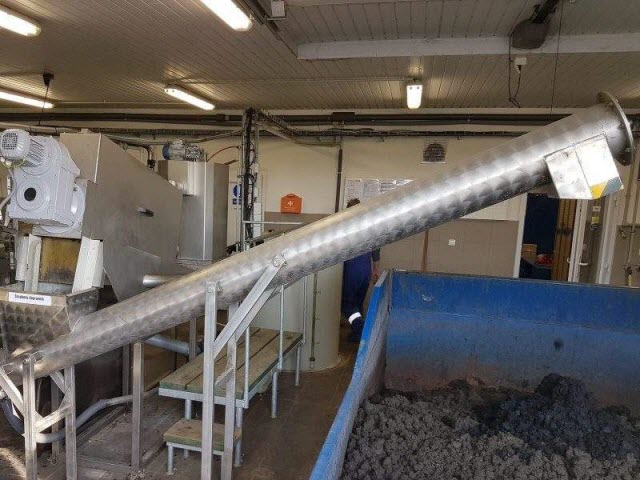
However, there are also some limitations to these technologies, including:
1) High capital cost: Both the DSP and screw press dryer can be expensive to install, especially for small plants.
2) Maintenance requirements: The screw press requires regular cleaning and maintenance to prevent blockages and maintain optimal performance.
3) Operator skill level: The operation of the screw press requires skilled operators who can adjust the equipment settings for optimal performance.
sludge handling and dewatering are essential steps in the wastewater treatment process, and the DSP and screw press dryer are two common mechanical dewatering options. While these technologies have several advantages over other dewatering methods, they also have some limitations that need to be considered when selecting the appropriate dewatering technology for a particular plant.
Filter Press
A filter press is a type of dewatering equipment used to separate solids from liquids in a variety of industrial applications, including wastewater treatment, mining, chemical processing, and food production. It operates on the principle of pressure filtration, where a slurry of solids and liquids is pumped into a series of filter plates, which are then pressed together under high pressure to force the liquid through the filter media, leaving behind a cake of dewatered solids.
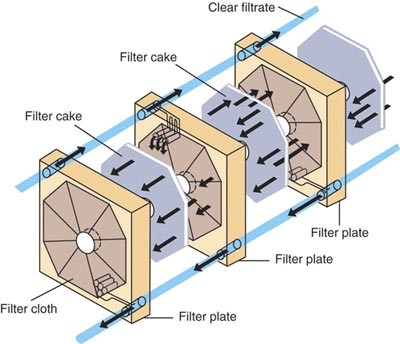
The basic components of a filter press include:
I. Frame: The frame supports the filter plates and holds them together during the filtration process. The frame can be made of steel or other materials and can be designed to withstand high pressures.
II. Filter plates: The filter plates are stacked together to form a series of chambers where the slurry is filtered. The plates are typically made of plastic or metal and are designed to withstand high pressures.
III. Filter media: The filter media is placed between the filter plates and is responsible for separating the solids from the liquids. The media can be made of a variety of materials, including cloth, paper, or mesh.
IV. Hydraulic system: The hydraulic system is used to apply pressure to the filter plates, which compresses the slurry and forces the liquid through the filter media.
The filtration process typically involves several stages, including:
I. Filling: The slurry is pumped into the filter press, filling the chambers between the filter plates.
II. Filtration: Once the slurry is in the filter press, the hydraulic system applies pressure to the plates, forcing the liquid through the filter media and leaving behind a cake of dewatered solids.
III. Washing: After the filtration process is complete, the filter cake is washed with water to remove any remaining liquids or impurities.
IV. Discharge: Finally, the dewatered solids are discharged from the filter press and can be further processed or disposed of.
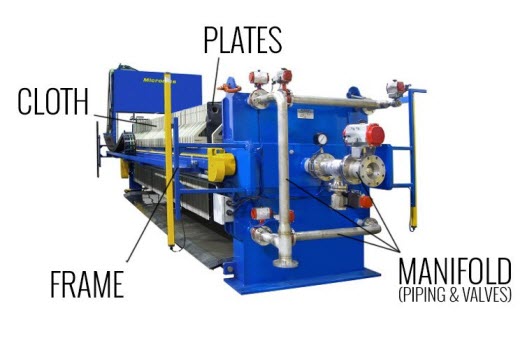
Filter presses have several advantages over other dewatering methods, including:
a) High solids capture: Filter presses can achieve high solids capture rates, resulting in a drier and more stable cake.
b) Consistent performance: Filter presses can provide consistent performance over time, making them suitable for continuous operations.
c) Flexibility: Filter presses can be used for a variety of applications and can be customized to meet specific process requirements.
However, there are also some limitations to filter presses, including:
a) High capital cost: Filter presses can be expensive to install and maintain, especially for small plants.
b) Maintenance requirements: Filter presses require regular cleaning and maintenance to prevent blockages and maintain optimal performance.
c) Operator skill level: The operation of a filter press requires skilled operators who can adjust the equipment settings for optimal performance.
Grit Removal and Dewatering Solutions for High Quality Sludge
Grit removal and dewatering are important steps in the treatment of wastewater to produce high-quality sludge. Grit is a common contaminant in wastewater and can cause damage to downstream equipment such as pumps and piping, as well as reducing the effectiveness of the treatment process. Dewatering is the process of removing water from sludge to reduce its volume and weight, making it easier and more cost-effective to transport and dispose off.
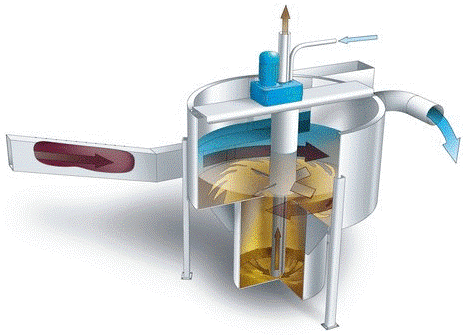
There are several grit removal and dewatering solutions available, including:
1) Grit removal systems: Grit removal systems are designed to remove heavy solids such as sand and gravel from the wastewater stream before it enters the treatment process. These systems typically use vortex separators, aerated grit chambers, or hydro cyclones to separate the grit from the wastewater. The removed grit can be further processed for reuse or disposal.
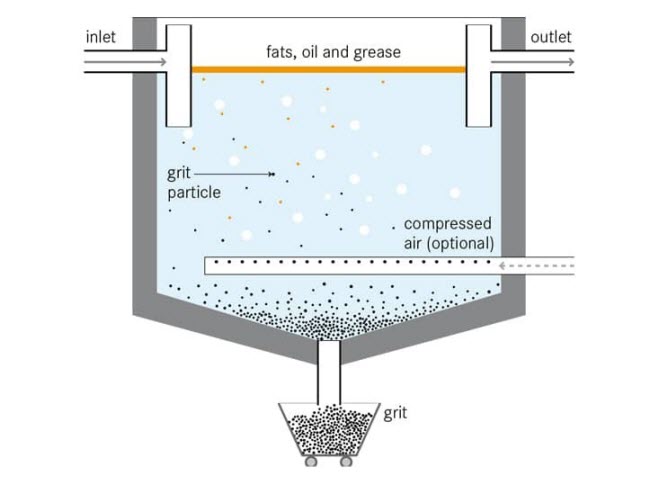
2) Centrifuges: Centrifuges are commonly used for sludge dewatering, where the sludge is fed into a rotating drum that separates the water from the solids by centrifugal force. The dewatered sludge can be further processed or disposed of.

3) Belt filter presses: Belt filter presses are another popular method for sludge dewatering. In this process, the sludge is fed onto a continuous belt filter, which presses the sludge between two porous belts, squeezing out the water and forming a cake of dewatered sludge. The cake can then be further processed or disposed of.
4) Screw presses: Screw presses are another option for sludge dewatering, where the sludge is fed into a rotating screw that applies pressure to the sludge, forcing the water out and forming a cake of dewatered sludge. The cake can then be further processed or disposed of.
Overall, grit removal and dewatering are critical steps in the treatment of wastewater to produce high-quality sludge. There are several solutions available, including grit removal systems, centrifuges, belt filter presses, and screw presses, each with their own advantages and disadvantages. The choice of solution will depend on factors such as the size of the treatment plant, the type of sludge being processed, and the desired level of dewatering.
Sludge Dewatering Equipment
1. Dewatering bags
2. Screw dehydrators.
3. Filter presses
Sludge dewatering equipment is used to remove water from sludge, reducing its volume and weight and making it easier and more cost-effective to transport and dispose of. Here are three types of sludge dewatering equipment:
• Dewatering bags: Dewatering bags are made of porous fabric and are used to filter sludge. The sludge is pumped into the bag, and the water is slowly released through the fabric, leaving behind a dewatered sludge cake. Dewatering bags are relatively simple and inexpensive but may have limited capacity and require frequent replacement.
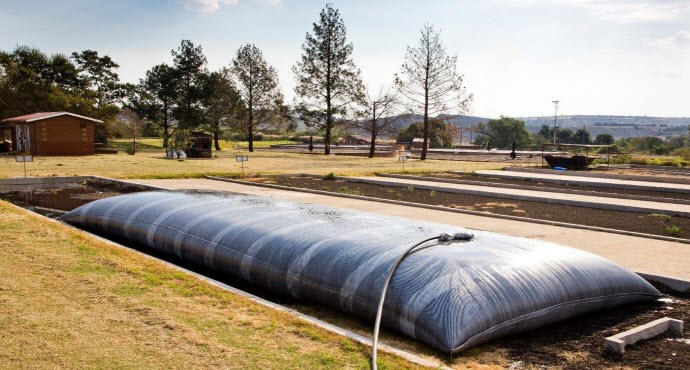
• Screw dehydrators: Screw dehydrators use a rotating screw to apply pressure to the sludge, forcing the water out and forming a dewatered sludge cake. The screw dehydrator is a continuous process and is particularly useful for sludge that is difficult to dewater. The screw dehydrator is also relatively compact and can be easily automated.
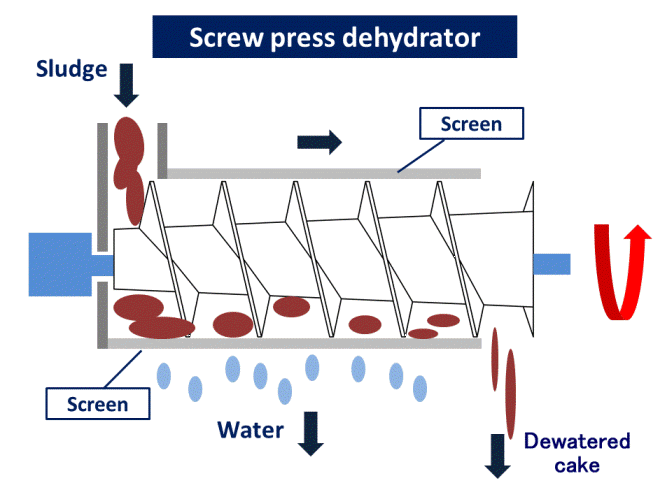
• Filter presses: Filter presses are widely used in sludge dewatering. The sludge is pumped into a series of chambers separated by filter plates, and pressure is applied to the sludge, forcing the water out and forming a dewatered sludge cake. The filter press is effective for dewatering a wide range of sludge types but can be relatively expensive and complex to operate.
Each of these sludge dewatering equipment types has its advantages and disadvantages, and the choice of equipment will depend on factors such as the size of the treatment plant, the type of sludge being processed, and the desired level of dewatering.
Sludge Drying Equipments
1. Paddle Dryer,
2. Thin Sludge Dryer,
3. Agitated Thin Film Dryer,
4. Rotating Paddle Dryers
Sludge drying equipment is used to reduce the moisture content of sludge, making it easier and more cost-effective to transport and dispose of. Here are four types of sludge drying equipment:
• Paddle dryer: Paddle dryers are commonly used for sludge drying. The sludge is heated and mixed continuously by paddles, which promote heat transfer and increase the drying rate. The dried sludge is then discharged from the dryer. Paddle dryers are effective for drying a wide range of sludge types and have relatively low energy consumption.
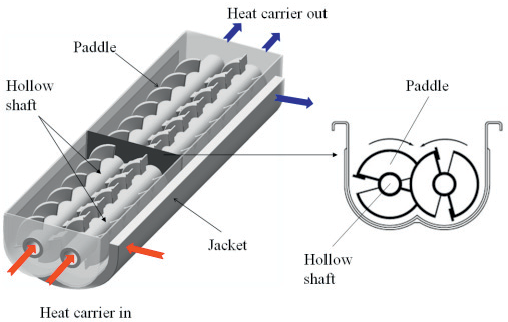
• Thin sludge dryer: Thin sludge dryers use a heat pump to evaporate the moisture in the sludge, creating a concentrated sludge product that is easier to transport and dispose of. Thin sludge dryers are particularly useful for small treatment plants or sites with limited space.

• Agitated thin film dryer: Agitated thin film dryers use a rotating drum with a heating jacket to dry the sludge. The sludge is fed into the drum, and the rotation and heating promote evaporation, creating a dried sludge product. Agitated thin film dryers are effective for drying viscous sludge and have a compact design.
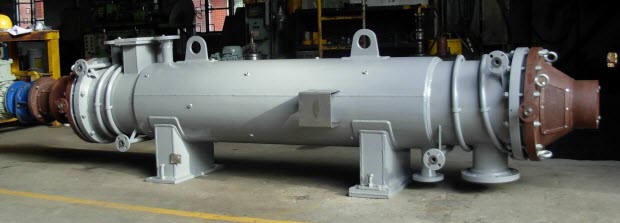
• Rotating paddle dryers: Rotating paddle dryers are similar to paddle dryers, but the sludge is fed into a rotating drum with internal paddles. The sludge is heated and mixed by the paddles, promoting heat transfer and drying. Rotating paddle dryers are effective for drying sludge with high moisture content and have relatively low energy consumption.
Each of these sludges drying equipment types has its advantages and disadvantages, and the choice of equipment will depend on factors such as the size of the treatment plant, the type of sludge being processed, and the desired level of drying.
Drying Sludge for Optimal Recovery and Evaporating The Water in The Sludge
Drying sludge for optimal recovery is an important aspect of sludge management. By reducing the moisture content of sludge, it is easier and more cost-effective to transport and dispose of, and it can also be further processed for resource recovery.
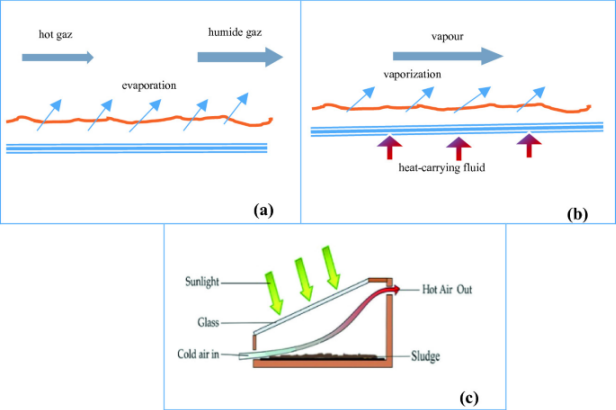
There are several drying processes that can be used to evaporate the water in the sludge and achieve optimal recovery:
i. Direct drying: In this process, the sludge is dried using direct heat, such as hot air or flue gas. Direct drying is a simple and cost-effective method but may require high energy consumption.
ii. Indirect drying: Indirect drying involves using a heat transfer medium, such as steam or hot oil, to transfer heat to the sludge. This process is more energy-efficient than direct drying but may require additional equipment.
iii. Solar drying: Solar drying uses the sun’s energy to evaporate the water in the sludge. This process is environmentally friendly and can be cost-effective in sunny areas.
iv. Freeze drying: Freeze drying involves freezing the sludge and then drying it in a vacuum at low temperatures. This process is effective for preserving the sludge’s quality and can be used for high-value products, such as food and pharmaceuticals.
v. Mechanical drying: Mechanical drying processes, such as centrifugation or screw pressing, can also be used to remove water from sludge. These processes are effective for dewatering sludge but may not achieve optimal recovery.
Each drying process has its advantages and disadvantages, and the choice of process will depend on factors such as the type of sludge being processed, the desired level of recovery, and the available resources. It is important to select the most suitable drying process to achieve optimal recovery while minimizing costs and energy consumption.
Comparison of Dryers
1. Sludge dryer
2. Slurry dryer
3. Waste dryer
Sludge dryer, slurry dryer, and waste dryer are all types of drying equipment used in various industries for reducing moisture content and achieving optimal recovery. Here are some comparisons between these dryers:
i. Sludge dryer: Sludge dryers are designed specifically for drying sludge, which is a semi-solid material with a high moisture content. These dryers typically use indirect heating, which involves heating a heat transfer fluid, such as steam or hot oil, to transfer heat to the sludge. Sludge dryers are effective for drying a wide range of sludge types, including municipal wastewater sludge, industrial sludge, and biological sludge.
ii. Slurry dryer: Slurry dryers are used for drying slurries, which are mixtures of solids and liquids. Slurry dryers can use direct heating, such as hot air, or indirect heating, such as steam or hot oil, to evaporate the liquid and achieve dry solids. Slurry dryers are commonly used in the mining, chemical, and pharmaceutical industries.
iii. Waste dryer: Waste dryers are used for drying various types of waste materials, including municipal solid waste, industrial waste, and agricultural waste. Waste dryers can use direct heating or indirect heating to evaporate the moisture content and reduce the waste volume. Waste dryers can be effective for recovering resources, such as energy, from waste materials.

In terms of performance, sludge dryers are generally the most effective for drying sludge, while slurry dryers and waste dryers are more suitable for other types of materials. Sludge dryers have a high level of automation and can achieve optimal recovery of resources, such as energy and nutrients. Slurry dryers and waste dryers may require more manual operation and may not achieve the same level of recovery.
When selecting a dryer, it is important to consider the specific characteristics of the material being dried, as well as the desired level of recovery, energy consumption, and cost.
Sludge Treatment Plant Frequently Asked Questions
Q: What is a sludge treatment plant?
A: Sludge treatment facilities are built to handle the semi-solid waste that results from the treatment of wastewater. Reduce the volume and weight of the sludge, stabilise it, and create a product that can be properly disposed of or used are the objectives of a sludge treatment plant.
Q: What are the main processes involved in a sludge treatment plant?
A: Sludge treatment plants typically involve several processes, including thickening, stabilization, dewatering, and disposal or reuse. Thickening involves increasing the solids content of the sludge, while stabilization involves reducing the organic content and pathogens. Dewatering involves removing the water from the sludge to reduce its volume and weight, and disposal or reuse involves safely disposing of or repurposing the treated sludge.
Q: What are the benefits of sludge treatment plants?
A: Sludge treatment plants offer several benefits, including reducing the volume and weight of sludge, stabilizing and reducing the organic content and pathogens, and producing a product that can be safely disposed of or reused. Sludge treatment plants can also help reduce environmental pollution by preventing untreated sludge from being released into the environment.
Q: What types of equipment are used in sludge treatment plants?
A: Sludge treatment plants use a variety of equipment, including thickening and dewatering equipment such as belt filter presses, centrifuges, and screw presses, as well as stabilization equipment such as aerobic and anaerobic digesters. Drying equipment such as paddle dryers and thin-film dryers may also be used to reduce the moisture content of the sludge.
Q: What are the environmental impacts of sludge treatment plants?
A: Sludge treatment plants can have both positive and negative environmental impacts. On one side, they aid in preventing the release of untreated sludge into the environment, which may be detrimental to aquatic life and people’s health. On the other hand, they consume energy and produce greenhouse gas emissions, particularly during the dewatering and drying processes.
Q: What are some of the challenges associated with sludge treatment plants?
A: Sludge treatment plants can be complex and expensive to operate and require skilled personnel to ensure optimal performance. They also require significant energy inputs, particularly during the dewatering and drying processes, which can be a source of greenhouse gas emissions. Additionally, sludge treatment plants may face community opposition due to concerns about odours, noise, and other environmental impacts.
Q: What is a filter press?
A: A filter press is a dewatering equipment that uses pressure to separate solids from liquids. It consists of a series of plates with filter cloths in between that are pressed together to form a chamber. A cake of dewatered particles is left behind after the sludge is poured into the chamber and the liquid is squeezed out via the filter cloths.
Q: What are the advantages of using a filter press for sludge dewatering?
A: Filter presses offer several advantages for sludge dewatering, including high solids capture rates, low energy consumption, and the ability to handle a wide range of sludge types. They are also highly customizable and can be designed to meet specific process requirements.
Q: What is a screw press?
A: A screw press is a dewatering equipment that uses a slowly rotating screw within a cylindrical screen to dewater sludge. The sludge is pumped into the screw press and is conveyed along the length of the screw, while the water is forced through the screen and discharged. The dewatered solids are discharged at the end of the screw.
Q: What are the advantages of using a screw press for sludge dewatering?
A: Screw presses offer several advantages for sludge dewatering, including high solids capture rates, low energy consumption, and continuous operation. They are also highly compact and can be easily integrated into existing wastewater treatment systems.
Q: What types of sludge are suitable for dewatering using filter presses and screw presses?
A: Filter presses and screw presses are both suitable for dewatering a wide range of sludge types, including primary sludge, secondary sludge, and mixed sludge. They can also be used to dewater industrial sludges from a variety of industries, such as food and beverage, pulp and paper, and chemical manufacturing.
Q: How do I choose the right dewatering equipment for my sludge treatment plant?
A: The type of sludge being treated, the amount of sludge produced, and the target moisture content of the dewatered solids are all important considerations when selecting the appropriate dewatering equipment for your sludge treatment plant. Waterman Engineers Australia can provide expert advice on selecting the best dewatering equipment for your specific needs.
Q: What is sludge drying?
A: Sludge drying is the process of removing moisture from sludge in order to reduce its volume and weight and make it easier to handle and dispose of. This can be done through various drying technologies, such as thermal drying, solar drying, and mechanical drying.
Q: Why is sludge drying important in sludge treatment?
A: Sludge drying is crucial to the treatment of sludge because it reduces the volume and weight of sludge, making transportation and disposal simpler and less expensive. It also reduces the risk of odour and pathogen emissions associated with wet sludge.
Q: What types of sludge drying technologies are available?
A: There are several types of sludge drying technologies available, including thermal drying (such as direct or indirect rotary dryers), solar drying (such as greenhouse or sludge drying beds), and mechanical drying (such as belt dryers or paddle dryers).
Q: How do I choose the right sludge drying technology for my sludge treatment plant?
A: Choosing the right sludge drying technology depends on several factors, such as the type and volume of sludge being treated, the available space and resources, and the desired final moisture content of the dewatered sludge. Waterman Engineers Australia can provide expert advice on selecting the best sludge drying technology for your specific needs.
Q: What are the benefits of using sludge drying technologies?
A: Using sludge drying technologies offers several benefits, such as reducing the volume and weight of sludge, reducing the risk of odour and pathogen emissions, and producing a more stable and usable end product (such as biosolids for land application).
Q: What is the difference between sludge drying and sludge incineration?
A: Sludge drying is the process of removing moisture from sludge, while sludge incineration is the process of burning sludge to ash. Sludge drying is generally considered to be a more sustainable and cost-effective option, as it produces a usable end product (such as biosolids) and requires less energy and capital investment than incineration.
Q: What is the Waterman Paddle dryer?
A: The Waterman Paddle dryer is a type of mechanical dryer that uses indirect heat to dry sludge. It features a paddle shaft that rotates inside a trough, with heated walls providing the indirect heat needed for drying.
Q: What are the benefits of using the Waterman Paddle dryer for sludge drying?
A: The Waterman Paddle dryer offers several benefits, such as efficient and uniform drying of sludge, low energy consumption, low maintenance requirements, and the ability to handle high solids content sludge with ease.
Q: How does the Waterman Paddle dryer work?
A: The Waterman Paddle dryer works by using a paddle shaft to agitate and move sludge through a heated trough. The heated walls of the trough provide indirect heat to dry the sludge, while the paddles ensure even mixing and exposure to heat.
Q: What types of sludge can be dried using the Waterman Paddle dryer?
A: Many different kinds of sludge, including industrial, municipal, and wastewater sludge, can be dried using the Waterman Paddle dryer.
Q: What is the drying capacity of the Waterman Paddle dryer?
A: The drying capacity of the Waterman Paddle dryer varies depending on the size and model of the equipment, but it is capable of handling high solids content sludge and can achieve a final moisture content of less than 10%.
Q: Is the Waterman Paddle dryer energy-efficient?
A: Yes, the Waterman Paddle dryer is designed to be energy-efficient, with low energy consumption requirements compared to other types of sludge dryers.
Q: What is the maintenance requirement for the Waterman Paddle dryer?
A: The Waterman Paddle dryer is designed for low maintenance requirements, with simple and easy-to-access components that can be quickly and easily replaced if needed.
Q: Can the Waterman Paddle dryer be customized for specific sludge drying needs?
A: Yes, Waterman Engineers Australia can work with clients to customize the Waterman Paddle dryer for specific sludge drying needs, such as adjusting the size or shape of the equipment to fit the available space or increasing the heating capacity for higher drying rates.
Q: What is sludge handling?
A: Sludge handling refers to the process of collecting, transporting, storing, and treating sludge produced during wastewater treatment processes.
Q: What are the different methods of sludge handling?
A: The different methods of sludge handling include thickening, stabilization, dewatering, drying, and disposal or reuse.
Q: What are the challenges of sludge handling?
A: Sludge handling can be challenging due to the high volume of sludge produced, its high moisture content, and its potential to cause odours and environmental pollution if not properly treated and disposed of.
Q: What are the benefits of efficient sludge handling?
A: Efficient sludge handling can help reduce the environmental impact of wastewater treatment processes, minimize operational costs, and generate valuable by-products such as biogas and biosolids.
Q: What is the role of sludge handling in sludge treatment plants?
A: Sludge handling is a crucial component of sludge treatment plants, as it ensures the proper collection, storage, and treatment of sludge to reduce its volume and prepare it for safe and effective disposal or reuse.
Q: What are the safety considerations for sludge handling?
A: Safety considerations for sludge handling include the use of personal protective equipment, proper training for handling and operating equipment, and ensuring proper ventilation and air quality to prevent exposure to harmful gases and chemicals.
Q: What are the environmental impacts of poor sludge handling?
A: Poor sludge handling can lead to environmental pollution, contamination of soil and water resources, and emission of harmful gases such as methane and hydrogen sulphide.
Q: How can sludge handling be optimized for better efficiency and cost-effectiveness?
A: Sludge handling can be optimized by using advanced technologies and equipment such as automation systems, sludge thickening and dewatering equipment, and sludge drying systems, as well as implementing best management practices for sludge handling and disposal.
Q: What are the benefits of sludge dewatering?
A: The benefits of sludge dewatering include reduced transportation and disposal costs, increased efficiency of downstream treatment processes, reduced environmental impact, and potential revenue streams from the by-products of sludge.
Q: What are the challenges of sludge dewatering?
A: The challenges of sludge dewatering include the high cost of equipment and operation, the variable nature of sludge characteristics, and the need for proper maintenance and optimization of dewatering equipment.
Q: How does sludge dewatering affect the quality of the final effluent?
A: By decreasing the amount of sludge that needs to be treated further down the line, sludge dewatering can increase the quality of the final effluent while decreasing the load on the further downstream operations.
Q: What are the safety considerations for sludge dewatering?
A: Safety considerations for sludge dewatering include the use of personal protective equipment, proper training for handling and operating equipment, and ensuring proper ventilation and air quality to prevent exposure to harmful gases and chemicals.
Q: How can sludge dewatering be optimized for better efficiency and cost-effectiveness?
A: Sludge dewatering can be optimized by using advanced technologies and equipment, such as automation systems, sludge thickening and dewatering equipment, and real-time monitoring and control systems. Proper maintenance and optimization of dewatering equipment is also important to ensure maximum efficiency and cost-effectiveness.
Q: What is sludge thickening?
A: Sludge thickening is the process of increasing the concentration of solids in sludge by removing as much water as possible.
Q: Why is sludge thickening important?
A: Because sludge thickening reduces the volume and weight of sludge, it is easier to manage and more affordable to dispose of. Additionally, it makes downstream treatment procedures more effective.
Q: What is sludge stabilization?
A: Sludge stabilization is the process of reducing the biodegradability and odour of sludge by treating it with chemicals or biological processes.
Q: Why is sludge stabilization important?
A: Sludge stabilization is important because it reduces the potential health risks associated with sludge and reduces the odours associated with its storage and transportation.
Q: What are the methods of sludge stabilization?
A: The methods of sludge stabilization include aerobic digestion, anaerobic digestion, lime stabilization, and thermal hydrolysis.
Q: Why is sludge dewatering important?
A: Sludge dewatering is crucial because it lessens the volume and weight of sludge, making handling and disposal simpler and more affordable. Additionally, it lessens the danger of infection spread and environmental damage.
Q: What are the methods of sludge dewatering?
A: The methods of sludge dewatering include filter presses, screw presses, centrifuges, belt presses, and drying beds.
Q: What is sludge disposal or reuse?
A: Sludge disposal or reuse is the final step in the sludge treatment process where the treated sludge is disposed of or reused for other purposes.
Q: What are the methods of sludge disposal or reuse?
A: The methods of sludge disposal or reuse include land application, incineration, landfilling, and composting. Reuse options include energy recovery, soil conditioning, and fertilizer production.

